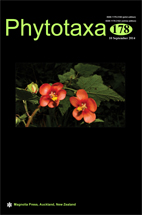Abstract
The genus Physalis Linnaeus (1753: 182) is a medium-sized genus in the family Solanaceae Jussieu (1789: 124). It includes about 75 New World species and one Eurasian species, P. alkekengi Linnaeus (1753: 183), the generic lectotype (Britton & Brown 1913). Recently, several phylogenetic analyses focusing on Physalis and related taxa strongly supported the monophyly of the morphologically typical New World species, characterized by unlobed and yellow flowers. Physalis alkekengi represents a divergent clade characterized by somewhat lobed, white corollas and brilliant red-orange fruiting calyces (Whitson & Manos 2005; Olmstead et al. 2008). In order to emphasize the monophyly and morphological homogeneity of the New World species and decrease nomenclatural disruption, the genus Physalis was proposed for conservation with a conserved type, P. pubescens Linneaus, to represent the New World species (Whitson 2011). The Eurasian P. alkekengi was suggested to be placed in a monotypic genus Alkekengi Miller (1754: AL) typified with A. officinarum Moench (1802: 177). This proposal was subsequently recommended for acceptance by the Nomenclature Committee for Vascular Plants (Applequist 2012).

